
Herbs in Africa
Dehydration Apparatus
Part ~ 4
Part
~1
Part
~ 2
Part ~ 3
Part ~ 5
Part ~ 6
by
Ivor Hughes
| Part four in a series of articles which outline the basic requirements, for small scale, sustainable cultivation, and processing techniques, for rural communities continues. |
Introduction
The techniques for the preservation of foods,
along with the manufacture of stone and bone tools, must rank amongst
the very earliest of humankind's technological achievements.
Combination smoking and sun drying, was a common technique of
hunter-gatherer cultures, which still finds widespread usage today. Strips
of lean meat (jerky or biltong) may be quickly and efficiently preserved in
situ, by smoking and sun drying. The process of haymaking in temperate
climates, is sun drying on a large scale.
The sun drying of medicinal plants, or parts, is an extremely destructive
process, during which, up to 85% of the plants bio-activity may be lost in a
12 hour period. Compare that with warm air drying, where the economic
loss may be reduced to 35%, or with skill, to as little as 15% within
the same period of time.
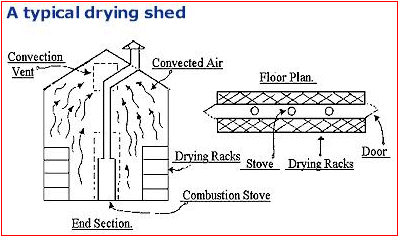
The Production of Warm Air - Simple Drying Shed.
In the early days of large scale herbal cultivation, such sheds were commonplace. The introduced innovations were the provision of heated air and drying racks which replaced the bunching and hanging of the herbs undercover. For the first time the commercial herb grower had a modicum of control over his main production process. The gains were considerable. The grower could plan harvesting and dehydration schedules and operate on a 24 hour basis at peak harvesting times. Temperature control was rudimentary and relied upon the opening and closing of convection vents and doors, and the damping controls on the combustion stoves. Ergonomically they left much to be desired and the crop dried in an uneven manner. This necessitated much turning and moving of the harvested material. Today the technology has advanced considerably and many high-tech solutions are available. However many of those solutions are not appropriate to the needs of small scale community production.
Appropriate Dehydrator Technology.
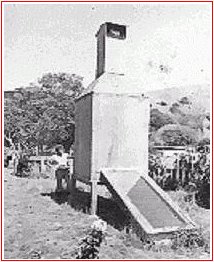 Solar Vertical Stack Dryer. New Zealand 1984. The
photograph is of my first, owner built solar dehydrator, which I operated
across 3 seasons. The sheathing was weather treated plywood. The solar air
heating panel to the front of the apparatus was constructed from
scavenged materials. The solar heat collecting plate was made from
corrugated roofing iron, painted matt black. It operated on the
principle of warm air convection. I was able, during sunny weather, to
heat the drying chamber to 40�C. That was usually, on average, 15�C
above ambient temperature. Crude temperature control was achieved by
means of an adjustable, ambient air flap, opposite, and at the same height
as the solar air inlet. The stack, which stands above the drying chamber,
houses two cheap plastic domestic bathroom convection fans to assist
the warm moisture laden air to be vented to the atmosphere. The fans
are powered by warm air convection and not electricity. The shape of the
drying chamber roof and the narrowing of the stack was intended to increase
the air velocity needed, to carry the vaporised water into the atmosphere
Solar Vertical Stack Dryer. New Zealand 1984. The
photograph is of my first, owner built solar dehydrator, which I operated
across 3 seasons. The sheathing was weather treated plywood. The solar air
heating panel to the front of the apparatus was constructed from
scavenged materials. The solar heat collecting plate was made from
corrugated roofing iron, painted matt black. It operated on the
principle of warm air convection. I was able, during sunny weather, to
heat the drying chamber to 40�C. That was usually, on average, 15�C
above ambient temperature. Crude temperature control was achieved by
means of an adjustable, ambient air flap, opposite, and at the same height
as the solar air inlet. The stack, which stands above the drying chamber,
houses two cheap plastic domestic bathroom convection fans to assist
the warm moisture laden air to be vented to the atmosphere. The fans
are powered by warm air convection and not electricity. The shape of the
drying chamber roof and the narrowing of the stack was intended to increase
the air velocity needed, to carry the vaporised water into the atmosphere
Observations and Comments
The sheathing was three ply. So that in those
months that it was used operationally. Considerable solar heat gain
was garnered. It was also light in weight. The apparatus was
constructed so that it could be easily stripped down, and reassembled at a
new site. Therefore it would have potential to be manufactured in kit
sets. Now that sounds like a good community project to me!
The dryer is simple. However some thought must be given to the size of the
drying chamber, which in turn influences the dehydrator herb loading. The
size of the chamber must also bear some relationship to the size of
the cultivation. This in order to prepare a proper harvesting and
dehydration schedule. The size of the drying chamber will influence
the size of the solar panel. The panel must be sized to give the
required heat gain needed for successful operation. It produced herb of good
aroma and cosmetic quality. The negatives were, it was only
operational from sunrise to sunset. There was always a risk of dew point
being reached in the dehydrator during the hours of darkness. I would close
the dehydrator down at dusk. This I did by closing off the air inlet from
the solar panel vent and opening the dehydrator door in order to cool the
heated herb down to ambient temperature. This decreased the risk of
dew point in the dehydrator. The door was then closed and the ambient
air inlet flap opened slightly. Operations commenced again 45 minutes
after dawn.
Different Types of Dehydrators
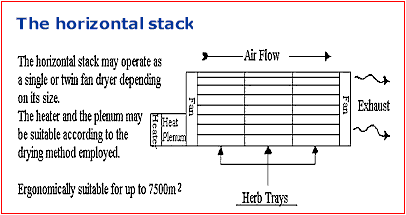
The Hybrid System
Considerable savings in energy may be achieved by including a solar air heating panel as the air inlet for the heating plenum.
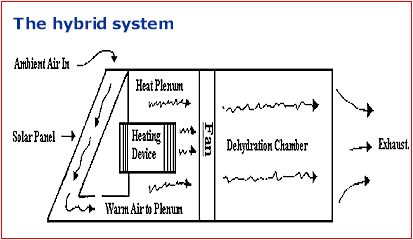
The horizontal stack and tunnel dryer are fuel burners and use electricity powered axial flow fans. The horizontal stack is side loaded. Pride of place
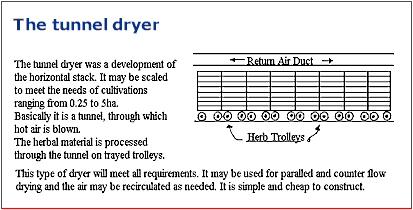
must go to the tunnel dryer, for use on the larger commercial cultivation. It can be constructed from adobe or mud bricks, soil cement bricks or concrete blocks. It has a Solar hot air panel which forms the roof. The furnace is constructed from a suitably modified 200L oil drum, which makes it economic in operation. The major expense is the power required for the fans. A system of vents allows for precise temperature adjustments and the recirculation of air. The dehydrator climate may be modified at will to allow the operator precise air and temperature control through the various drying phases. The moisture laden warm air on exit may be suitably condensed to produce single distilled water which bears a relationship to the herb from which it has been stripped. As such, after a further single distillation, it may be used as part of a hydro-alcoholic solvent, to extract the herb from which it was recovered.
Useful Data
Enthalpy of Evaporation.
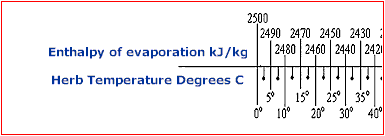
Solar Gain Chart
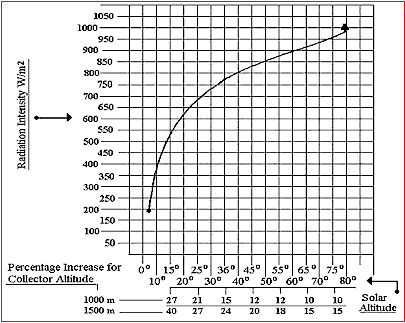
Conversion Technology
| Conversion Technology |
Extraction Technology |
Construction Technology |
Actual Conversion |
Total per G/W hour |
| Coal Fired |
1 |
1 | 962 | 964 |
| Oil Fired | ? | ? | 726 | 726++ |
| Gas Fired | ? | ? | 484 | 484++ |
| Geothermal | N/A | 3.7 | 300.3 | 340 |
| Hydro power | N/A | 10 | N/A | 10 |
| Wind | N/A | 7.4 | N/A | 7.4 |
| Photo voltaic | N/A | 5.4 | N/A | 5.4 |
| Solar Thermal | N/A | 3.6 | N/A | 3.6 |
| Wood on a basis of sustainable harvest |
Minus 1509.1 |
2.9 | 1346.3 | Minus 159.9 |
Combustion and Fuel Values
Combustion, or burning, is a chemical process
involving carbon, hydrogen and oxygen. Oxygen reacts with the fuel and
produces combustion products, some of which contribute to ozone layer
damage. The reaction is sensed as heat and light.
Combustibles may be solid, liquid or gaseous; and the fuel energy values
that follow should be read as mean global values, because the
hydrocarbon chemical content of fossil fuels, eg,. coal, oil or gas, vary
according to the geographical source. The same situation applies to
bio-mass fuels, eg., wood or ethanol.
Fuel Energy Values
| Fuel Type | Source | State | Energy kJ/kg |
| Carbon | Elemental | Solid | 33,000 |
| Coal | Fossil | Solid | 30,000 |
| Coke | Coal | Solid | 28,000 |
| Fuel Oil | Fossil | Liquid | 42,000 |
| Kerosene | Oil | Liquid | 45,000 |
| Petrol | Oil | Liquid | 45,000 |
| Coal Gas | Coal | Gaseous | 20,000 |
| Methane | Bio | Gaseous | 42,000 |
| Natural Gas | Oil | Gaseous | 38,000 |
| Charcoal | Bio | Solid | 33,000 |
| Ethanol | Bio | Liquid | 28,000 |
| Wood | Bio | Solid | 20,000 |
| Solar Energy | Sun | Radiant | 1.025 kW/m2 |
Library
Part ~1
Part ~ 2
Part
~ 3
Part ~ 5
Part ~ 6
The Pharmageddon Herbal
The
equivalent of a 3 year certificated course in Western Herbology, Save
yourself thousands.
These articles have been published in
Science In Africa
www.scienceinafrica.co.za
Next in this series:
Extraction apparatus
![]()